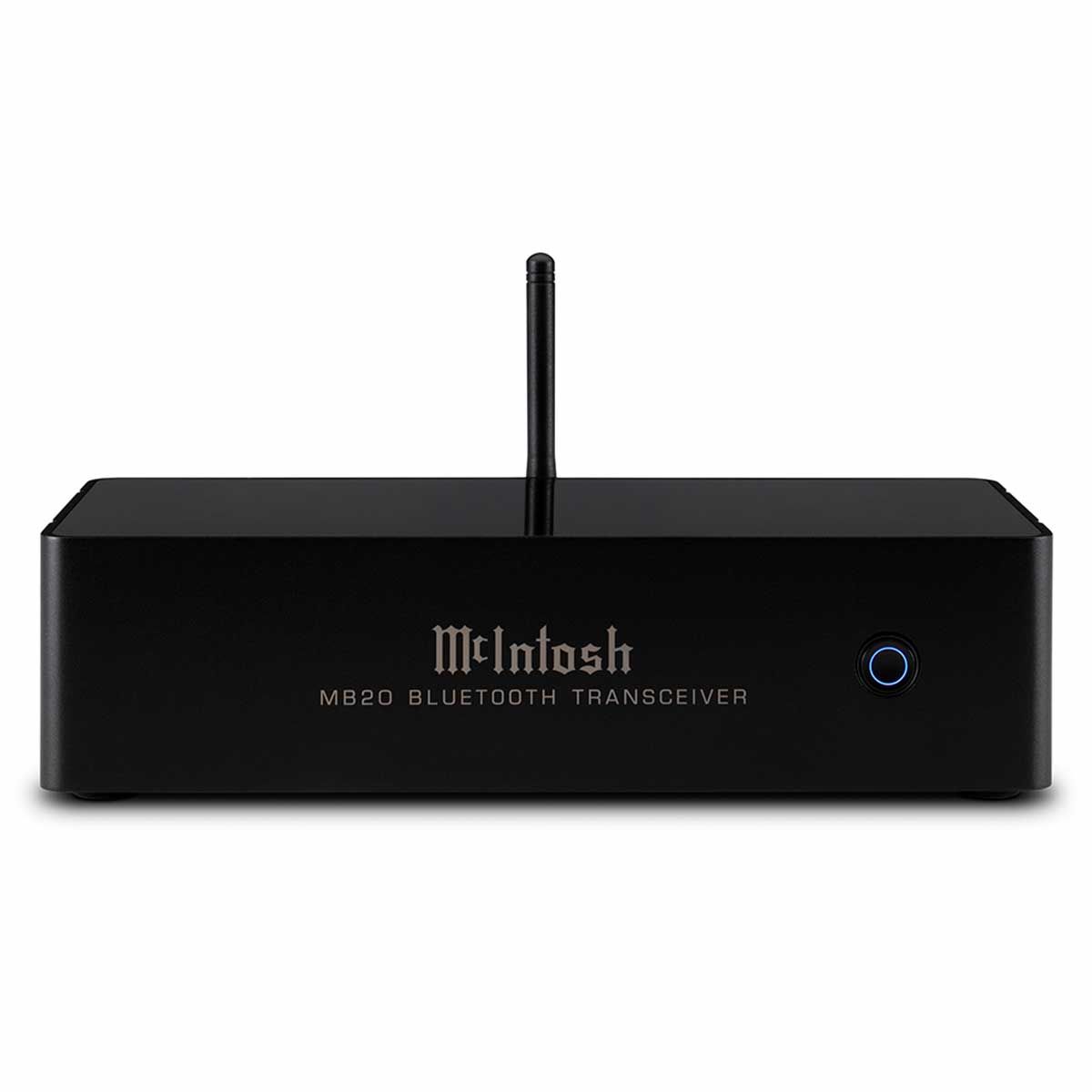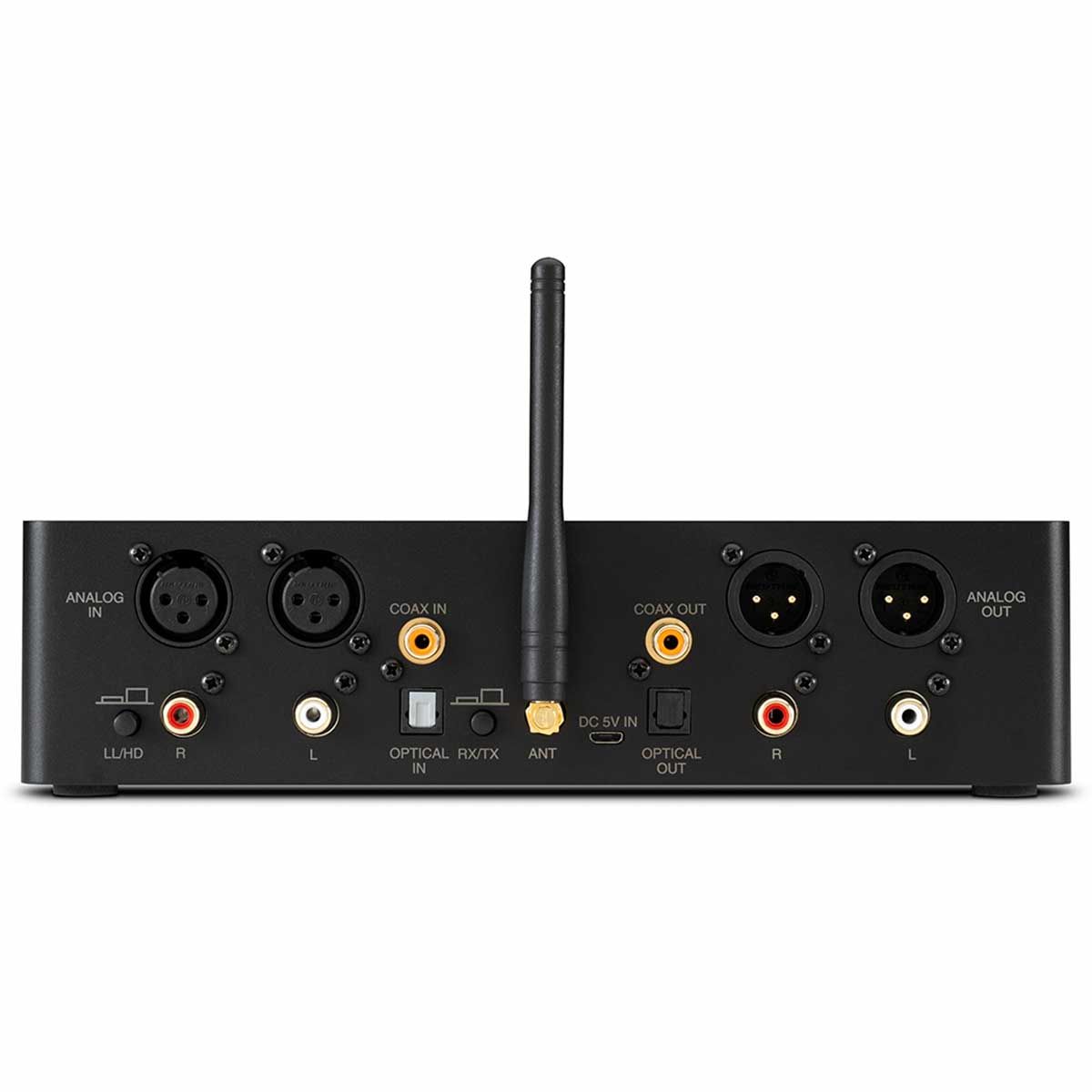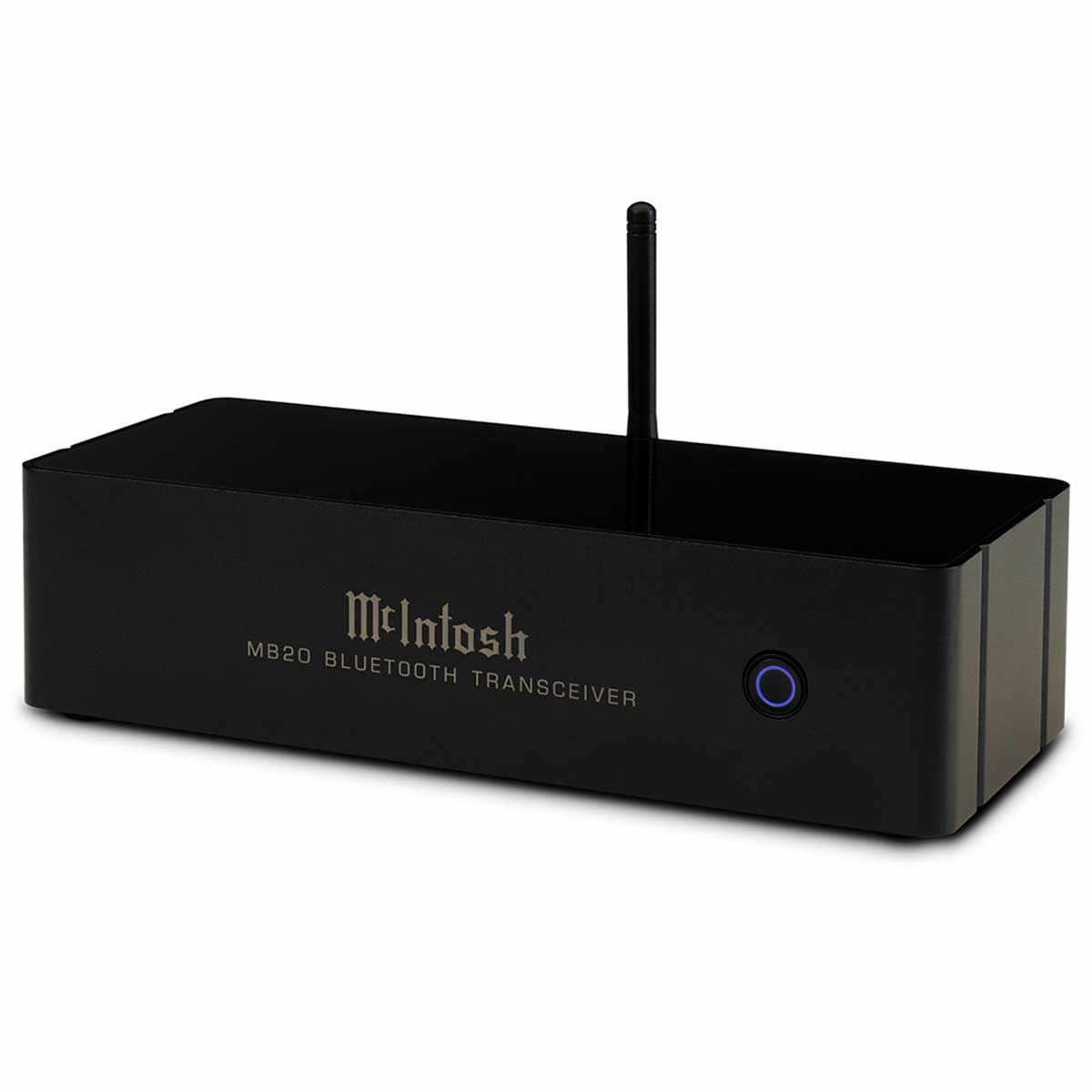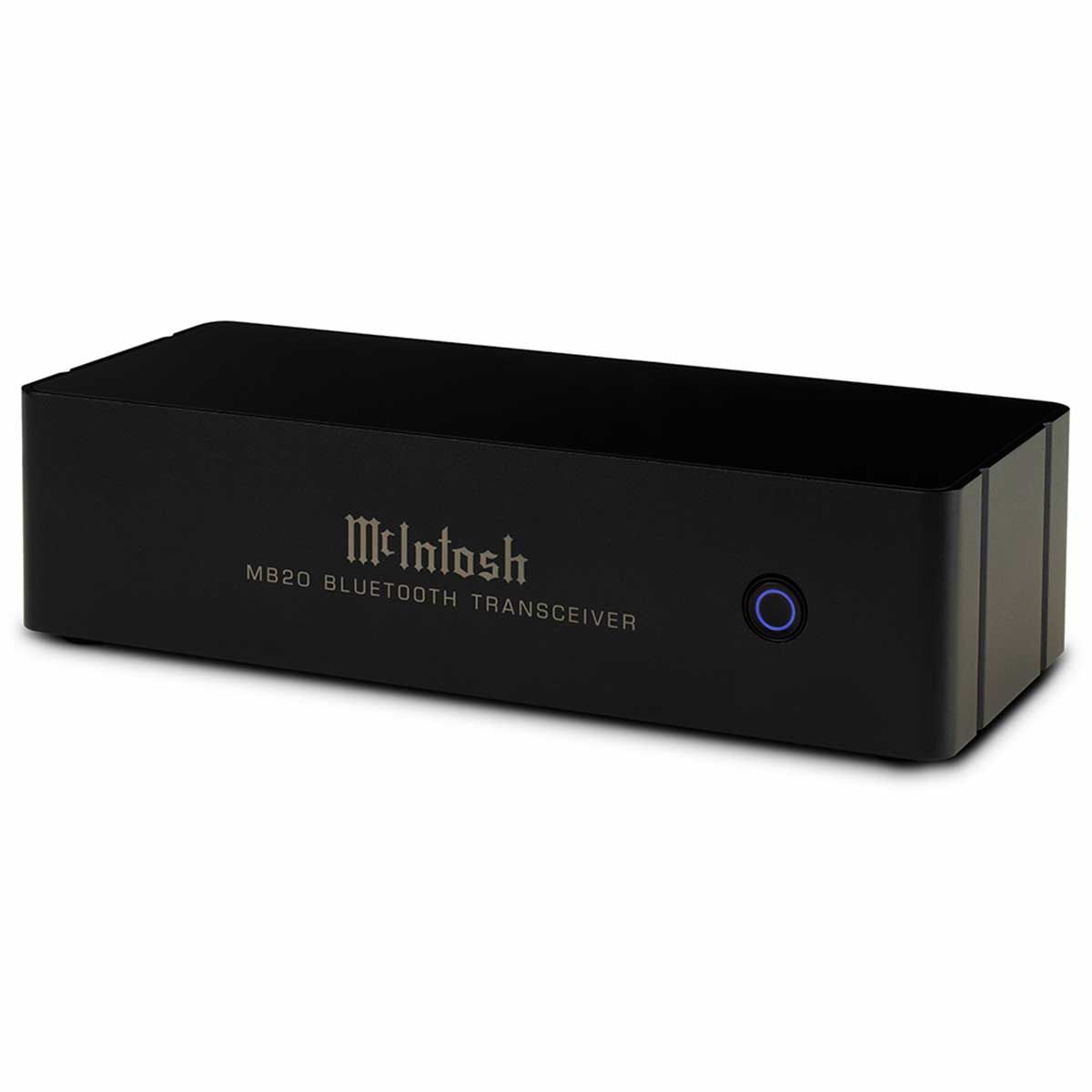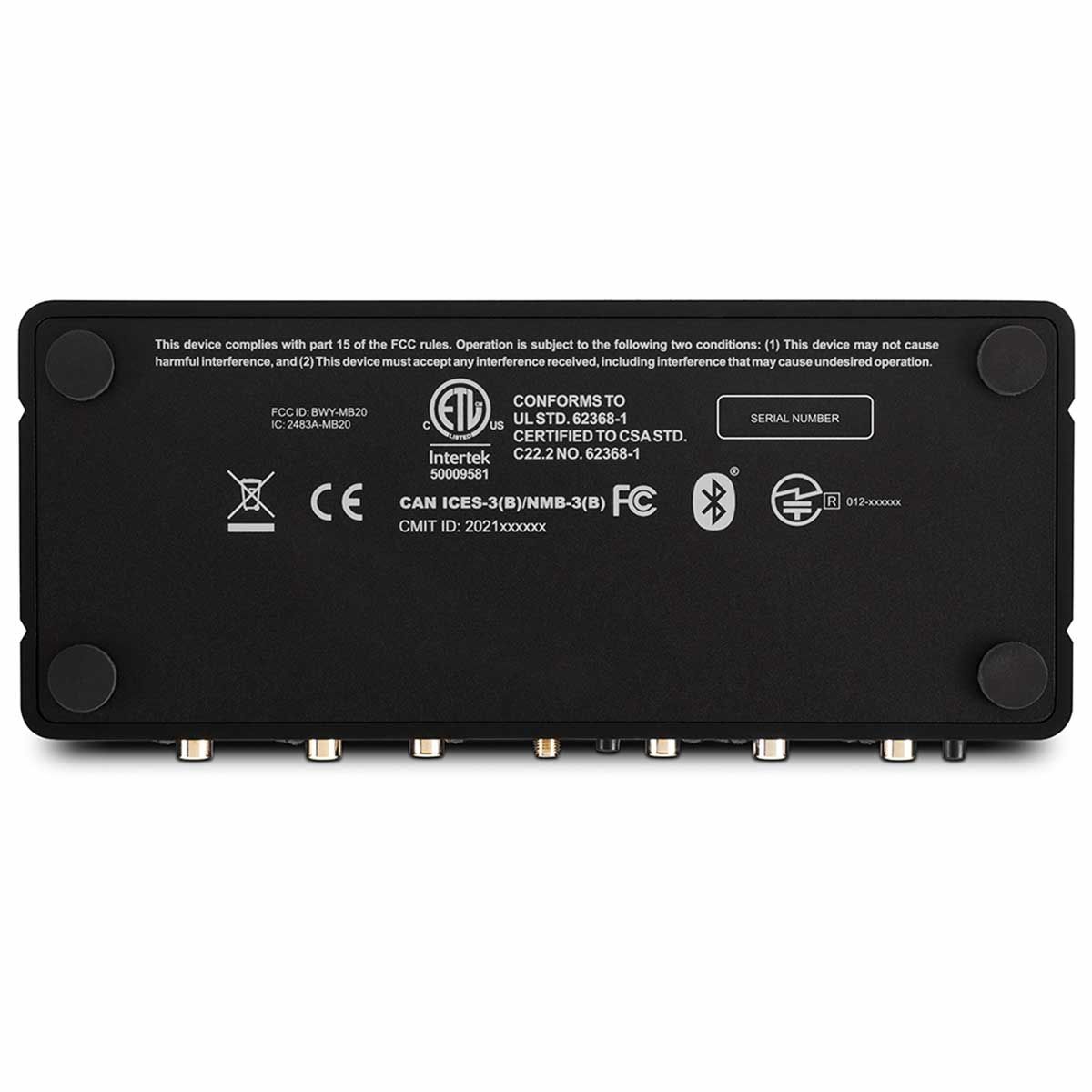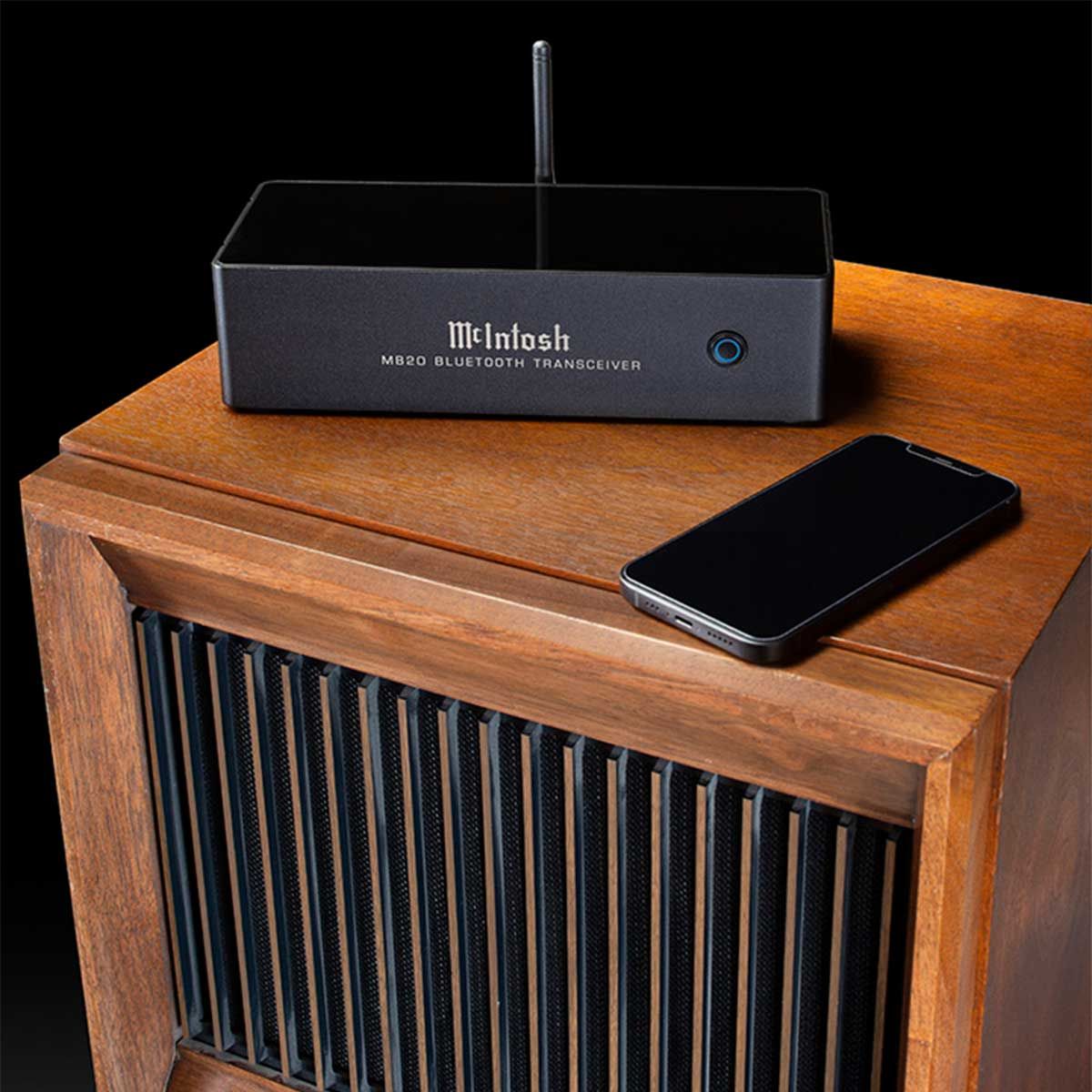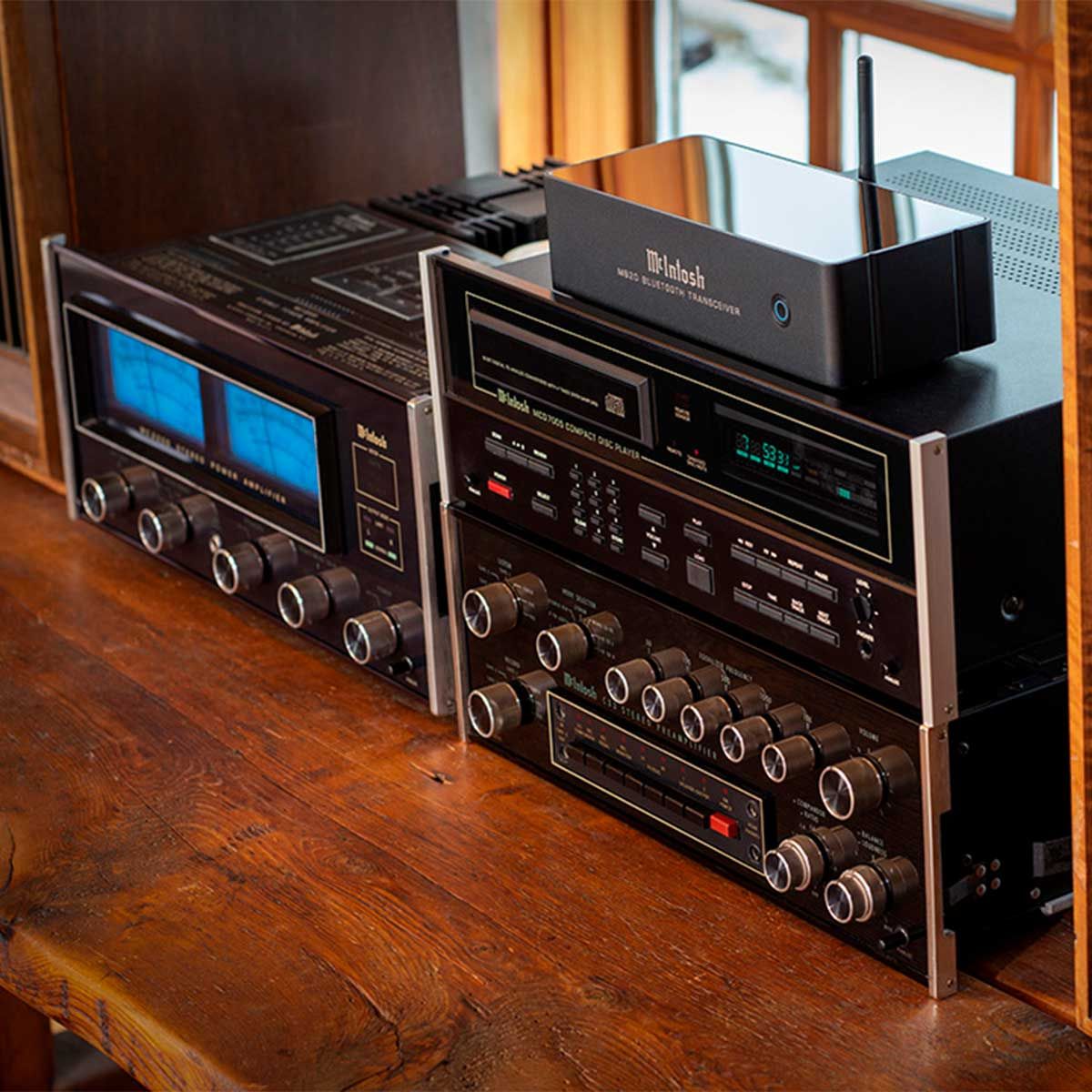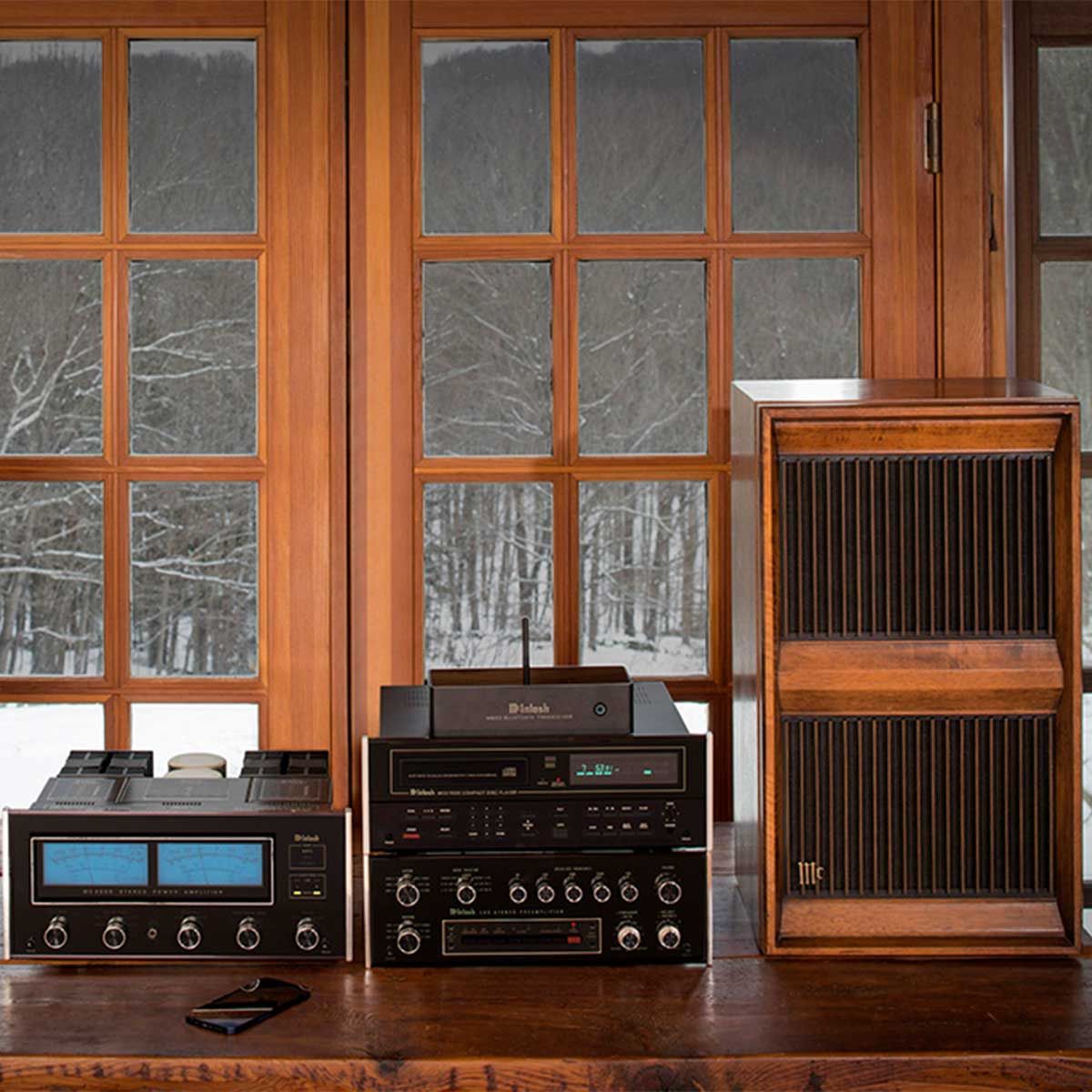McIntosh MB20
Bluetooth Transceiver w/ aptX HD, AAC, Balanced Inputs/Outputs, & 32-bit/195kHZ DAC
The MB20 Bluetooth Transceiver is an easy and simple solution to add Bluetooth streaming capabilities to virtually any McIntosh (or non-McIntosh) home audio system of any era. It can quickly turn a vintage McIntosh system that you've treasured for decades, or a family heirloom system that you've inherited, into a modern home music system capable of playing the digital music stored on your phone, in your cloud accounts, or from your preferred streaming services. It is a small (its footprint not much bigger than a smartphone), stand-alone, complete Bluetooth streaming solution that does not require any third-party apps to use.
High Notes
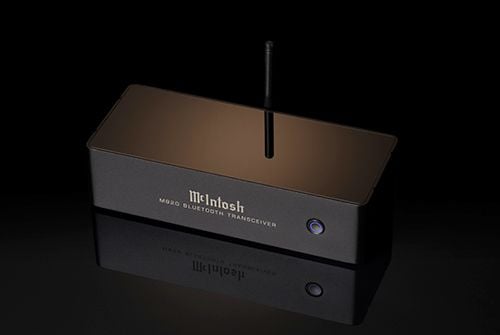
Bluetooth Any Way You Can Imagine It
The MB20 can act as both a Bluetooth transmitter or Bluetooth receiver giving you multiple ways to use it in your system. With all the connections, there are all kinds of use cases.
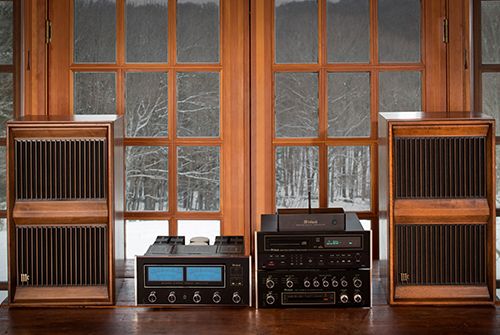
McIntosh Quality Throughout
This is no ordinary Bluetooth piece. It has a high-performance 32bit 192kHz DAC on board with processing to improve the Bluetooth signal. Plus it is built like all McIntosh gear, made to last with high-quality connections. You can even switch from High Def mode for audio to Low Latency for using it with video sources.
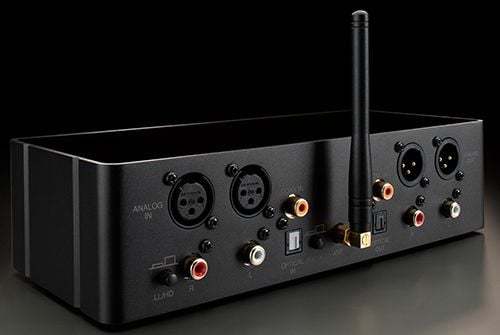
Inputs and Outputs Galore
With balanced audio, RCA audio, Toslink, and Coax all for inputs and outputs, the MB20 has more possible connections than any other Bluetooth device we have seen. This makes it super flexible for more than one type of use for most systems.
Company & Product Overview
If you know the name McIntosh, you are aware they produce some of the best built and natural-sounding audio equipment in the world. They have been headquartered in Binghamton NY for over 70 years with some employees working with them for many decades.
When McIntosh sets out to make a new type of product, their engineers are not happy unless it performs better than anything else in its class. When we first heard about the new McIntosh MB20 Bluetooth transceiver, we were very curious to see what McIntosh DNA would find its way inside a product that most people view as just an accessory. In typical McIntosh fashion, the MB20 is far from an accessory and designed with more flexibility than you might think at first glance.
In this article, we will go over all the technical details of what the MB20 can do, and share some use cases on some of the ways you might use it in your home.

Design & Build Quality
The engineers developed the MB20 to address the vast expanse of legacy McIntosh systems out there that had no way to access the new world of streaming music. McIntosh gear lasts for several decades and with streaming-only becoming mainstream in the past few years, there are over 60 years of McIntosh systems in people's homes with no way to easily stream music. And of course, like they always do, when they design a new product, the engineering team usually comes up with some pretty unique features.
Most Bluetooth products you will see are very tiny in physical size with a limited number of connections. The MB20 is far larger due to the better circuitry and audio input and output options. Generally, McIntosh pieces have the classic glass front that is beautifully backlit, but for the MB20, McIntosh chose to go the simple route to keep the price down to make it available to a wider group of their customers and people who own other high-performance audio pieces without streaming.
The MB20 is a basic black box with the McIntosh logo and product name screen printed on the front with the most connections on the rear we have ever seen on a Bluetooth piece of gear.
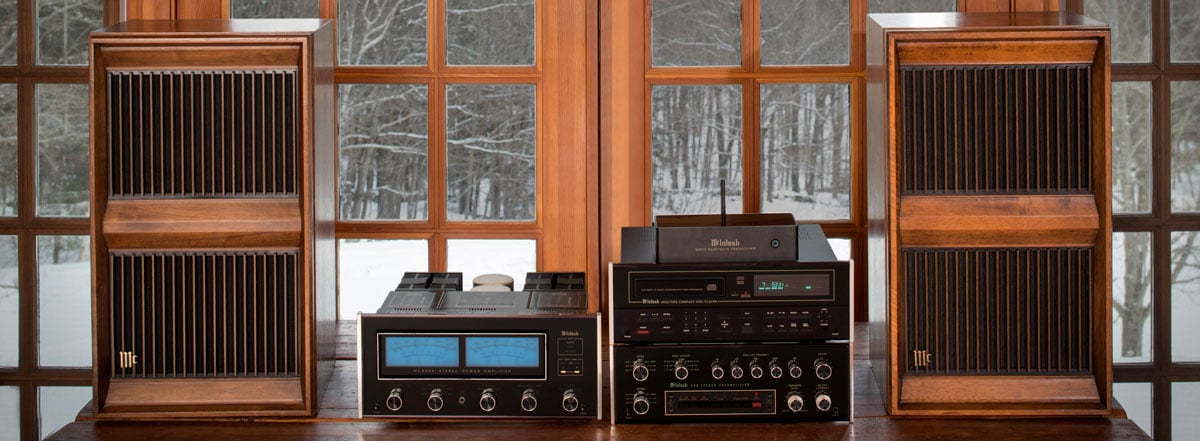
Features & Technology
Unless you have been totally disconnected from any tech at all, you have probably used Bluetooth at one time or another. It was developed as a way to send audio wirelessly between devices. When it first came out, the audio quality was pretty low, but as with all tech, things have progressed to where it is actually quite good, almost rivaling a wired connection.
Qualcomm, the developers of Bluetooth tech, came out with Bluetooth aptX HD in 2016 and it has been widely adopted as a great way to transmit audio from one device to another with minimal signal loss. As you might suspect, the MB20 uses aptX HD. This transmission method is still compressed but is pretty close to a hard-wired connection.
If you are into audio, you probably also know the quality of the DAC (digital to analog converter) makes a big difference in the sound. This is the device that converts the digital signal to analog. McIntosh uses a very high-performance DAC in the MB20 which is a 32-bit DAC with 192kHz internal processing to optimize sound quality.
Bluetooth aptX HD is present in most new models of wireless headphones and many Android-based phones, but is not available on Apple products. However, it is backward compatible with the Bluetooth transmitter on an iPhone.
Most Bluetooth accessories are either transmitters or receivers, but the MB20 can do both — although not at the same time. This means you can send a streaming music signal to it to get the sound into your legacy system, or you could use it to send the audio from your system to a pair of wireless headphones for example.

The number of inputs and outputs on the MB20 is what really impressed us and caused us to start thinking of interesting ways to use it. For inputs, you get a pair of balanced audio inputs, RCA audio inputs, Toslink digital in, and coax digital in. The output side has the exact same count and type. If you are going to use the digital audio outputs the signal will be 96kHz to make it more compatible with legacy DAC’s on the market that might not be new enough to do 192kHz. The inputs are all auto-switching, meaning whichever one has a signal present will be switched to.
The rear panel has two small buttons you might find yourself accessing if you plan to use the MB20 in more than one type of situation. We do wish these were on the front panel for easier access, but once you know where they are on the rear, it's pretty easy to get to them by feel. One button switches the unit between transmission mode or receive mode. The other puts it in a low latency mode or high definition mode. Bluetooth does have some latency or delay as some people call it which makes the low latency mode great for some applications we will go over next.
Performance & Use Cases
Most well-made Bluetooth devices have a pretty long-range as long as you do not have a lot of massive walls to go through. In almost all homes, you should be able to get from one side of your home to the other with no dropouts. The MB20 is no different and gave us a solid connection once we were paired up. We even found we could walk out of our store into the parking lot and maintain a solid connection.
Let’s go over some of the potential use cases for the MB20 Bluetooth Transceiver.
The most obvious one is setting it up as a receiver to get streaming music from your smartphone into your audio system. In this case, you make sure the button is in RX mode on the rear and the other is in HD. Then you can simply connect the audio outputs or digital outputs to your system to bring the world of streaming audio into any legacy system.
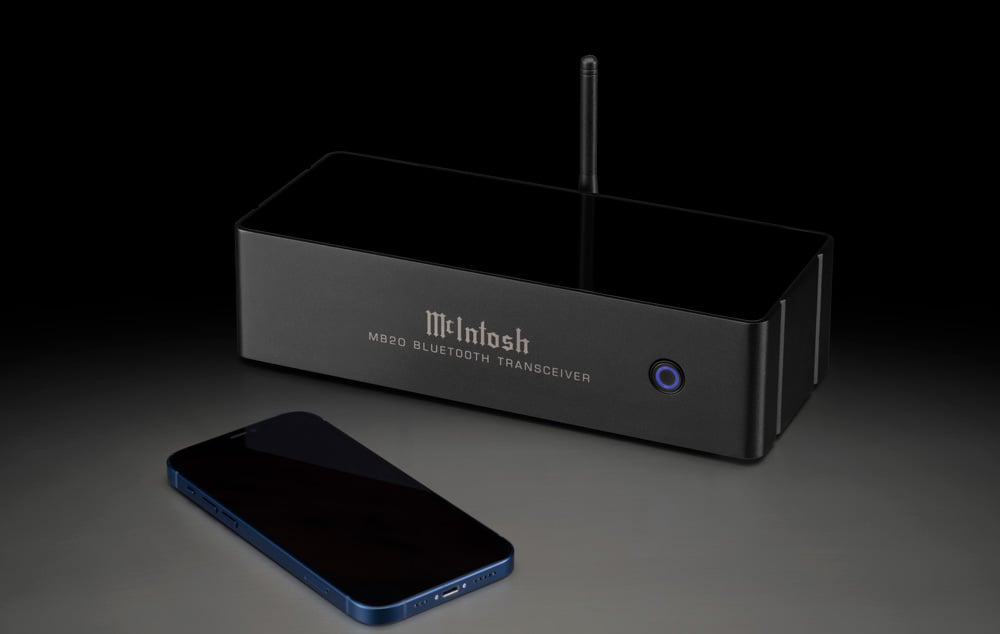
Another use might be for those of us who enjoy wireless headphones and the freedom they offer to roam around your home or just be cord-free. Here, you would set it up for TX mode and keep the quality setting in HD. With all of the rear connections, there are a multitude of ways to get a signal from your FM tuner, CD player, turntable, or tape deck into the MB20. For most older McIntosh systems, you would simply connect up a tape output that would allow you to choose the source being sent to the MB20. Then, you can walk around your home enjoying the sound from your audio sources on wireless headphones or even a wireless Bluetooth speaker system in another room.
Many of us need a solution to watch TV without disturbing others in the house, which brings up another use case for the MB20. Most TV’s have an optical audio out you could connect up to the MB20 and then transmit the TV sound to your wireless headphones. In this case, you set it to TX and want to put the quality button in LL for low latency to keep the audio in sync with the picture.
It is possible you have two audio systems in different parts of your house and have always wanted a way to connect them. Well, if you purchase a second MB20, you can put one in transmit mode and the other in receive. Then you could send a signal from one system to the other. You will need to make sure the quality button is in the same position on both of them. If you want both systems to play at the same time and you can hear them together, you will want to use low latency mode to keep them in sync, but if you just want to go from one to the other we suggest you use the HD mode.
As you can tell, with so many input and output options, the MB20 is extremely flexible and its use is only limited by your imagination!
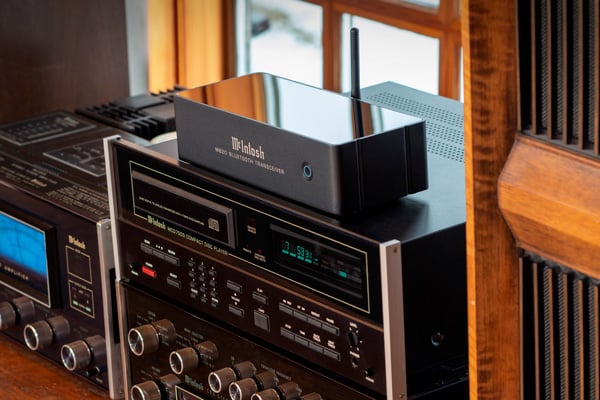
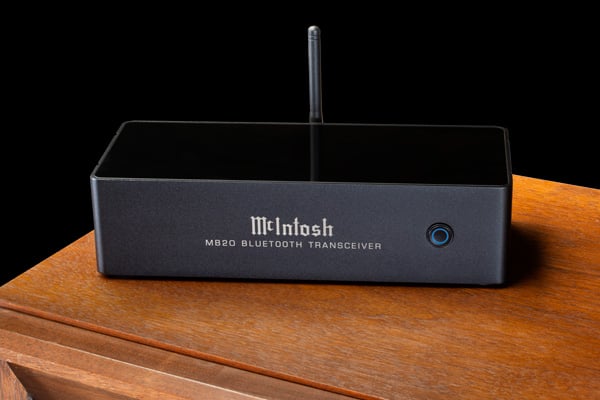
Overall Recommendation
As Bluetooth receivers go, the MB20 is at the high end of the price range. But it is built like a McIntosh piece and performs flawlessly. And if you are a McIntosh fan, you typically don’t want any other kind of electronics in your system. We do feel, if you only wanted to stream music into an older system, there are some other component options from Sonos and Bluesound that can give you a wired connection and better performance. These do cost more though and do not have the transmit option like the MB20 does. We think most users will find the MB20 is a great way to get into the world of streaming and also use it with their wireless headphones for TV, audio sources, or both. In that respect, there is nothing on the market like it with the high-tech DAC’s found in the MB20. Once again, the engineering team in Binghamton, NY has come up with a winner!
As a transmitter/receiver, the MB20 has been designed to provide a superior Bluetooth connection to audio equipment that lacks Bluetooth connectivity. As such, it has been engineered as a Class 1 Bluetooth device. Class 1 devices can typically operate at a range of up to 150 feet (45.7 meters)1 in ideal conditions with limited obstructions. As a Receiver, the MB20 employs an extremely sensitive receiver for better reception, even from Class 2 devices, with the maximum range determined by the capabilities of both actively paired devices. An external antenna helps maximize its range for better performance. As a Transmitter, it has a range 10x greater than that of a typical Class 2 Bluetooth device.
The compact MB20 comes with a variety of analog and digital inputs and outputs to connect it to your home audio system – most notably amongst them being balanced inputs and outputs, making it one of the only Bluetooth transmitter-receivers to offer these superior audio connections that help deliver top-quality audio performance. For connecting it to your system via analog cables, it includes 1 stereo set of both balanced and unbalanced inputs, along with a stereo set of balanced and unbalanced outputs. For digitally connecting it to your system, such as for use with an outboard Digital-to-Analog Converter (DAC), it has 1 each of both coaxial and optical inputs and outputs
The MB20 uses Bluetooth® 5.0 with support for both the high bitrate Advanced Audio Coding (AAC) standard as well as Qualcomm® aptX™ HD for hi-res audio playback. It also features Qualcomm aptX Low Latency for improved audio transmission speed to deliver sound in sync with applicable visual media. When used as a Receiver, the MB20 uses a high-performance 32-bit DAC with 192kHz internal processing for optimum sound quality; when used in combination with a separate outboard DAC, the MB20's digital output is fixed at 96kHz to be compatible with most third-party DACs in order to maximize performance and maintain audio signal integrity. When in Transmitter mode, it uses an equally capable high-performance Analog-to-Digital Converter (ADC) with 110dB Signal-to-Noise Ratio (SNR).
As a transceiver, the MB20 can function as either a Bluetooth Receiver or Transmitter (but not both at the same time). Simply set the switch on the back panel to the proper setting for the desired Receiver or Transmitter usage.
Usage examples:
- In Receiver mode, you can stream to the MB20 via Bluetooth from any compatible device with Bluetooth streaming capabilities; this audio can then be played through your McIntosh system regardless of when your amplifier or preamplifier was made.
- When in Transmitter mode, you can stream from the MB20 to any device capable of receiving Bluetooth streaming audio. In this setup, you could stream the music stored on physical media, such as CDs or vinyl records, to your wireless Bluetooth headphones or wireless Bluetooth speakers.
- If you have more than one audio system in your home that are within range of each other, then a third option is to add an MB20 to each system and set one to Transmitter mode and the other(s) to Receiver mode. Then you could stream music stored on a physical medium, such as from a CD player or turntable, from one system to the other system(s) in your home. Or if you have the need for a high-performance audio link from one part of your house to another but running cables is not possible, then two MB20s wirelessly connected in this manner could create a full wireless encode/decode bridge.
The MB20 comes in a black, custom aluminum chassis with a black glass top panel, letting it fit right in with any McIntosh system. The MB20 will also work with any non-McIntosh home audio system that has the proper inputs and outputs. It includes a wall mount charger with adapters for some of the most common outlets used around the world.
Electronic Specifications
- Total Harmonic Distortion: < 0.005%
- Frequency Response: +/-0.5dB from 20Hz to 20,000Hz
- Maximum Volts Out (Balanced / Unbalanced): 5/2.5 V RMS
- Signal To Noise Ratio: > 100dB
- Output Impedance Minimum load: 500 Ohms
- Dynamic Range: N/A
Connectivity
- Balanced Input: 1
- Balanced Output: 1
- Unbalanced Input: 1
- Unbalanced Output: 1
- Digital Coaxial Input: 1
- Digital Coaxial Output: 1
- Digital Optical Input: 1
- Digital Optical Output: 1
- Digital USB Input: 0
- Digital USB Audio Output: 0
- Network Connection: Bluetooth
- DVI Output: 0
- HDMI Output: 0
- VGA Output: 0
- eSata Input: 0
Digital Audio Specifications
- Digital Input Format: PCM
- Digital Input Sample Rate: Up to 24-Bit/192kHz
- Digital Output Format: 24-Bit/96kHz
- Digital Output Sample Rate: 96kHz
Control
- Power Control Input: 0
- Power Control Output: 0
- Rear Panel Data Input: 0
- Rear Panel IR Sensor Input: 0
Weights & Dimensions
- Unit Dimensions (W x H x D): 9-29/64" (24cm) x 2-1/2" (6.35cm) (antenna in upright position adds additional 1-3/8" (3.43cm) x 3-15/16" (10.01cm)
- Unit Weight: 2.5 lbs (1.2kg)
- Shipping Weight: 3.5 lbs (1.6kg)
| UPC | 842548110236 |
|---|---|
| Warranty | 1 Year |

